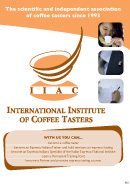The markers of non-quality
by Roberto Zironi
He is professor of Food Industries at the University of Udine and president of the Department of Food Science in the same University. In addition, he is the chair of the scientific committee of the International Institute of Coffee Tasters and vice-president of the International Academy of Sensory Analysis.
 Coffee is a drink that expresses most of its sensory characteristics in its smell and its aroma. The aroma is the sensory characteristic resulting from a combination of smells contributed by the chemical substances and by their intrinsic synergies and is the result of high-quality raw materials and of technological steps for the processing of the green matrix into roasted coffee which are thoroughly carried out. It is important to point out that the aromatic precursors are already present in the green bean which, exposed to roasting, develops new substances that contribute to the complexity with more than 800 volatile components found in a cup of coffee.
Coffee is a drink that expresses most of its sensory characteristics in its smell and its aroma. The aroma is the sensory characteristic resulting from a combination of smells contributed by the chemical substances and by their intrinsic synergies and is the result of high-quality raw materials and of technological steps for the processing of the green matrix into roasted coffee which are thoroughly carried out. It is important to point out that the aromatic precursors are already present in the green bean which, exposed to roasting, develops new substances that contribute to the complexity with more than 800 volatile components found in a cup of coffee.
With regard to coffee, quality is based on two main aspects: the hygienic-sanitary quality, defined by regulations in force, and the sensory quality, defined by the aromatic and sensory profile.
Let us start with the hygienic-sanitary quality. For both the Arabica and Canephora (Robusta) varieties there are regulatory restrictions re the quantity of Ochratoxin A (OTA), secondary metabolite of moulds, mainly belonging to the Aspergillus type, present in both the green and the roasted coffee. Such restrictions are the result of proven negative effects on the consumer’s health. It is interesting to point out how the presence of OTA often goes hand in hand with a low sensory quality given that the attacks of moulds also bring about the formation of several secondary metabolites capable of influencing both the aroma and the taste of the finished product.
The contamination by moulds, coming from the raw material as well as from inadequate conditions during harvesting, processing, storage and transportation is among the factors which have the greatest impact on the sensory quality of a coffee. Components produced by moulds such as the 2-methylisoborneol, the geosmin and the 2,4,6-tricloanisole (TCA), for example, are responsible for major off-flavours: they create sensations of mouldy, earthy phenic, and rio flavour. It goes without saying that the absence of the said flaw-producing elements can be deemed as the first step towards impressive productions. Therefore, the above-mentioned elements can be seen as markers of non-quality to be determined, alongside the traditional parameters, during the qualitative assessment of a batch of green coffee.
In collaboration with: E.Cossio, F.Battistutta
Tags: arabica, battistutta, canephora, coffee, cossio, geosmin, green coffee, markers, ochratoxin, ota, Quality, roberto zironi, tca, tricloanisole

